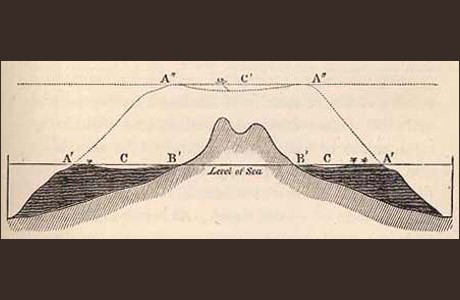Seeing Corals with the Eye of Reason
A rediscovered painting celebrates Charles Darwin’s view of life.

Atoll with lagoon, Maldives, Indian Ocean
The sweetest words to a scientist, to paraphrase Isaac Asimov, may be not “Eureka! I’ve found it!” but “Hmm . . . that’s funny. What’s that doing there?” A historian of science often has the same experience: a bit of data pops up that just doesn’t seem to fit in with the rest. Yet, if greeted with curiosity and openness, the anomaly can lead to an unanticipated treasure. I experienced such a serendipitous moment on October 3, 2006, in a small museum storage building in the English countryside. It wasn’t as dramatic as detecting an unaccounted wobble in a planetary orbit, or a Staphylococcus-free zone around a growth of Penicillium mold. But a seemingly out-of-place painting in the archive of the Bromley Museum, near Charles Darwin’s home in Kent, set off an unexpected cascade of insights into Darwin’s life and thought.
The Bromley Museum (located in Orpington, in the London borough of Bromley) houses an important collection of local history in a medieval stone hall called the Priory. I had learned that among its treasures is a trove of about twenty paintings of prehistoric scenes produced by an artist collaborating with a scientist, possibly the very first examples of the genre now called “paleoart.” They were created in 1871—the same year that Darwin published The Descent of Man—when the idea of the great antiquity of humankind was still new and startling. The artist, Ernest Griset, whose drawings often appeared in Punch magazine, worked with pioneer prehistorian and polymath John Lubbock, Darwin’s protégé and only student. The scion of a banking family, Lubbock had commissioned the series of paintings.


When I visited the Priory, Adrian Green, the curator at the time, invited me to the small storehouse behind the museum, where he showed me the dramatic Griset watercolors. Spear-toting hunters chased bison or surrounded a woolly mammoth in some of the images, while other paintings depicted tribal life in the Paleolithic and Neolithic. (Lubbock had coined both terms in his 1865 book, Pre-historic Times.) Such imaginary reconstructions may seem commonplace today, but they were a bold departure from primal scenes based on stories of the Bible. It was a pleasure to view them, knowing they had been locked away for many years and had never even been published. My heart truly raced, though, when Green pulled out a triptych of a tropical coral island encircling a blue lagoon, fringed with palm trees and white sand. “This one is signed and dated 1871 by the same artist, Ernest Griset,” he said. “But we don’t have any idea what it is, or why it is archived here with Lubbock’s prehistory collection.”
I instantly had a hunch, however, strengthened when a tiny detail caught my eye—a sailing ship near the horizon of the painting’s central panel. Darwin loved coral lagoon islands and theorized about their origins. His first scientific book, which he published in 1842, was The Structure and Distribution of Coral Reefs. In it he described three types of coral reefs: barrier reefs, which rise like walls out of the sea, separated from land by a channel; fringing reefs, which stretch along a shoreline; and atolls, which are circular islands that enclose a lagoon, like the one in Griset’s painting. Could this be a long-lost representation of one of Darwin’s atolls, commissioned by Lubbock as a surprise for the 62-year-old naturalist—complete with the ship of his youth, HMS Beagle?
Long before Darwin became interested in coral reefs and atolls, sailors and explorers had wondered how they originated. Some had suggested that fish— working together by the thousands—had built the structures by carrying grains of sand in their mouths. Others realized that the reefs had been built by billions of tiny softbodied polyps (Darwin called them “coral insects”) that secreted chambers of calcium carbonate around themselves. But why were such huge forms created, and how did atolls take on their circular shapes? Some naturalists considered coral reefs to be communal homes, like wasp nests or beehives, only on a much grander scale. No one yet had any idea of how deeply reefs were anchored in the sea, or how long it might have taken to produce one.

The young Darwin who embarked on the world-changing voyage of the Beagle may have been predisposed to a fascination with coral reefs thanks to his grandfather Erasmus. A physician, philosopher, botanist, inventor, and poet, Erasmus Darwin was the first naturalist in Europe to publish a coherent theory of evolution, anticipating many of Charles’s ideas by seventy years—and he did much of it in verse! (His book-length poem The Temple of Nature, for example, includes Islands and Continents raised by Earthquakes.) The Darwin family’s ancestral coat of arms consisted of three scallop shells in a row. To that escutcheon, Erasmus flamboyantly added the motto E conchis omnia (“everything from shells”). In 1770 he had it painted on his carriage, but later removed it when the local cleric’s accusations of blasphemy threatened his medical practice. It had been the eighteenth-century equivalent of displaying a Darwin Fish bumper sticker on a Kansas ambulance.